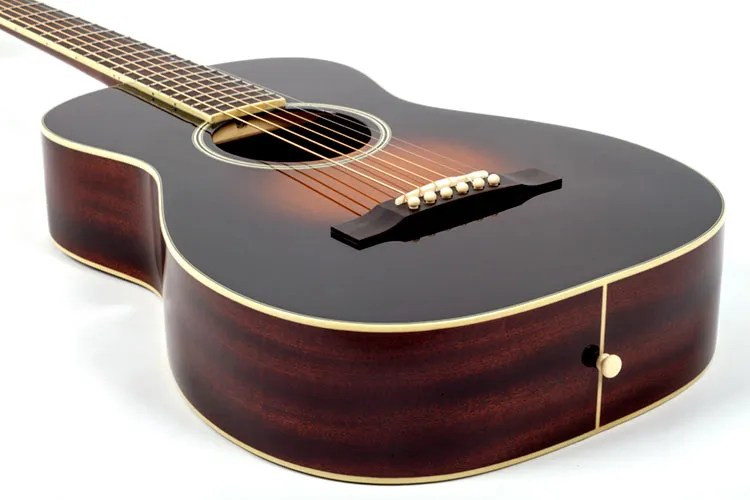For many years, the acoustic guitar landscape was dominated by the booming voices of jumbo and dreadnought guitars. These larger instruments are prized for their rich bass and powerful volume, but their size can be a significant drawback for some players, particularly those with smaller frames or a preference for more comfortable instruments.
Fortunately, smaller-bodied guitars, especially Parlor Guitars, have surged in popularity. This shift is fantastic for players seeking comfort and portability, though it often comes with accepted trade-offs in volume and bass response compared to their larger counterparts. However, the increasing variety of small guitars on the market means you can now be more selective, seeking out instruments that defy expectations in a compact form factor. The Gretsch G9511 Single-0 Parlor guitar is a prime example: an affordable, small-bodied instrument that delivers a surprisingly refined tone and enjoyable playing experience.
The Gretsch G9511, crafted in Indonesia, showcases impressive build quality for its price point. The “Appalachia Cloudburst” finish applied to the solid Sitka spruce top gives the guitar a captivating warm and smoky aesthetic. A thin gloss coating over the top and laminated mahogany back and sides provides a pleasing sheen. The mahogany neck features a matte finish, offering a smooth, silky feel preferred by many guitarists. Vintage-style butter-bean open-geared tuners add to the guitar’s classic vibe, while the bone nut and saddle complete its understated elegance. The frets are smoothly finished with no sharp edges, and the guitar is set up for comfortable play with low action and no fret buzz. Aside from a minor instance of finish overspray near the soundhole, the review model was remarkably free of imperfections.
Sound and Performance of the Gretsch G9511 Parlor Guitar
In evaluating the G9511’s sound, it became clear that this parlor guitar responds best to a lighter touch. While typically playing with a flatpick or thumbpick, the reviewer found themselves drawn to playing fingerstyle with bare fingers on this instrument. A gentle approach unveiled a sweet and nuanced tone, particularly appealing for jazzier musical styles. Although not primarily a jazz guitarist, the reviewer noted the alluring sound of major 7th and 13th chords on the Gretsch, highlighting its capacity for harmonic richness.
Transitioning to blues fingerpicking, a thumbpick was employed to explore John Hurt’s “Stagolee.” The Gretsch produced a surprisingly full sound, exceeding expectations for a parlor guitar, with a pleasing balance between bass and treble frequencies. Next, the low E string was tuned down to D to play William Moore’s “Old Country Rock.” A common concern with small-bodied guitars, especially those with light gauge strings (.012–.053), low action, and a shorter scale length (24.875 inches), is their potential to sound weak or muddy in lower tunings. However, the Gretsch again impressed, maintaining a strong tone even in drop-D tuning. The low D string retained definition and avoided sounding flabby or indistinct.
Inspired by this success, the tuning was lowered further to open D (D A D F# A D) to play “Vestapol.” Once more, the Gretsch defied expectations, handling the lower tuning admirably. The resulting sound possessed a captivatingly intimate and self-contained quality, characterized by warm midrange tones and clear, but not overly bright or harsh, trebles.
 Close-up of the Gretsch G9511 Parlor Guitar headstock and tuners, showcasing the vintage-style open-geared tuners and the "Gretsch" logo.
Close-up of the Gretsch G9511 Parlor Guitar headstock and tuners, showcasing the vintage-style open-geared tuners and the "Gretsch" logo.
The neck’s matte finish proved easy to navigate, and the 1.73-inch nut width, combined with a 2-3/8-inch string spacing at the bridge, provided ample room for both flatpicking and fingerpicking techniques. Gretsch describes the neck profile as a slim “C” shape, which contributed to comfortable playability. Returning to standard tuning, the reviewer explored flatpicking with The Beatles’ “I Feel Fine.” The Gretsch delivered a nice, crisp tone, almost reminiscent of an electric guitar, with single-string melodies projecting clearly. The primary limitation discovered was in the realm of aggressive strumming. Big, open G chords lacked the warmth and inviting character typically found on larger guitars. The harder the strings were strummed, the harsher the tone became. It’s also worth noting that the neck joins the body at the 12th fret, which may restrict access to the higher frets for some players.
Conclusion: Exceptional Value in a Parlor Guitar
In today’s market, players seeking a small-bodied acoustic guitar are presented with a wealth of options. However, at a street price of $299, it’s unlikely you’ll find many guitars that can match the Gretsch G9511’s combination of tonal complexity and ease of play. This parlor guitar offers exceptional value, making it a compelling choice for anyone seeking a smaller, more comfortable acoustic without sacrificing sound quality.
Gretsch G9511 Style 1 Single-0 Specifications
Body: Parlor-sized body with X-braced solid-spruce top and laminated mahogany back and sides; aged white binding; rosewood bridge with bone saddle; Appalachia cloudburst gloss urethane finish
Neck: 24.875″-scale mahogany neck with slim-C shape, 19-fret rosewood fingerboard with 12.6″ radius, 1.73″-wide bone nut, vintage-style open geared tuners, matte finish
Other: D’Addario EXP16–coated phosphor bronze, light gauge (.012-.053); optional gig bag or hardshell case
Price: $499 list/$299 street
Made in: Indonesia
Website: gretschguitars.com
Available at: Amazon


